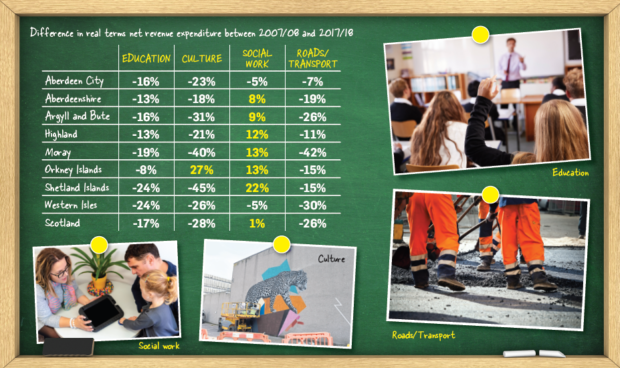Spending on education, culture and roads in the north and north-east has been slashed by more than £230 million in real terms over the last decade.
But social work investment has risen by £35m above inflation as councils are forced to divert resources to try to meet the rising demands of an aging population.
Official revenue figures suggest that across Scotland, almost £1 billion less was being spent on the day-to-day running of education in 2017/18, when compared to 2007/08, and accounting for inflation.
At the eight councils in the north and north-east, a combined total of £169m more was being spent on education in real terms a decade ago.
Compared to a national average drop in education expenditure of 17%, the Western Isles and Shetland Islands experienced a cut of 24%, Moray was down by 19%, Aberdeen City and Argyll and Bute both reduced by 16%, Aberdeenshire and Highland by 13% and Orkney Islands by 8%.
Pupil numbers, meanwhile, increased by 5.4% in the period in Aberdeenshire, and by 4.4% in Aberdeen City, but decreased by 12% in Argyll and Bute, 9.6% in the Western Isles, 5.5% in Moray, 3.8% on the Shetland Islands, 3.5% in Highland and 0.2% in Orkney Islands.
Culture spending, which includes museums, galleries, leisure and parks, was down by £30m in real terms at the eight councils, with a 40% drop recorded in Moray and 45% decline in Shetland.
And revenue expenditure on transport and roads, which does not include construction of new roads, had also fallen by more than £30m in northern Scotland.
But, while arrangements vary as previously council-run social care is merged with NHS services under integration joint boards, social work is the one area where spending has increased above inflation in many areas.
The only exceptions in the north and north-east were the Western Isles, and also Aberdeen, where adult social care services were moved to arm’s length body Bon Accord Care in 2013.
>> Keep up to date with the latest news with The P&J newsletter
John Finnie, Scottish Greens MSP for the Highlands and Islands and a former Highland councillor, said: “These figures clearly show the local government is toiling to retain services, let alone expand them to meet the growing demands of an increasing and ageing populations.
“Over the last three years Scottish Greens have secured over £500m for local services and secured bold changes to provide local government with greater flexibility, certainty and autonomy for the years ahead.
“However, more needs to be done to ensure councils are able to raise a greater percentage of their budget, rather than rely on funding from central government.”
A spokeswoman for the Educational Institute of Scotland teaching union said: “The era of austerity over the past decade has placed significant strain on schools, as a result of the continuing squeeze on education budgets.
“This has led to cuts to staffing, and to significant reductions in the resources available to schools to support learning and teaching.
“Schools have consistently expected to do more with less, but the continuing deep cuts to staffing and resources over the past decade have inevitably had an impact on the learning experience of pupils in schools across the country.
“Education is an investment in our young people and in the future of our country, so the policy of austerity has had a significant and long-lasting impact both for young people and for society as a whole.”
Alison Evison, an Aberdeenshire councillor and president of council body Cosla, said many services had faced cuts as local authorities attempted to sustain education, which accounts for about 40% of council budgets, and social work expenditure.
“Local government is facing a declining core budget for the essential services it provides and this is damaging to local democratic choice, as seen for example in the reduction in spending in many areas as we protect both education and social works,” she said.
The expenditure figures emerged just days after it was reported that there had been a real terms fall in spending since 2010 of £427 per primary pupil and £265 per secondary pupil across Scotland.
Tavish Scott, Shetland MSP and Liberal Democrat education spokesman, said: “The SNP claim that education is their number one priority but the gulf between rhetoric and reality has never been wider.
“From teachers pushed to the brink of national strikes by ever increasing workloads, to the continued failure to tackle the attainment gap, the SNP’s report card is filled with black marks.”
A Scottish Government spokesman said that there had been a real terms increase of 1% in education spending between 2016/17 and 2017/18, and that it was the third consecutive year that there had been a real terms rise.
He said education spending was now 3.1% higher than in 2014-15 in real terms, and that in 2019/20 the government was investing £269.6m in culture and heritage, and had increased road maintenance budgets by £33m to £467m.
“We continue to ensure that our partners in local government receive a fair funding settlement, despite further cuts to the Scottish Budget from the UK Government,” he added.
“Local authorities are autonomous bodies, and it is the responsibility of individual councils to manage their own budgets and to allocate the total financial resources available to them on the basis of local needs and priorities.”










